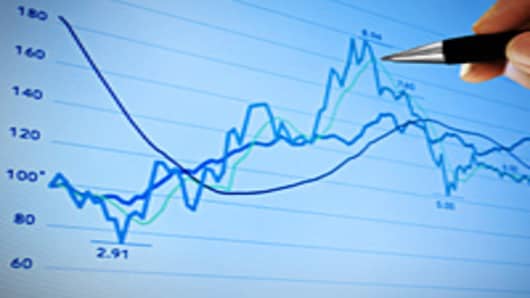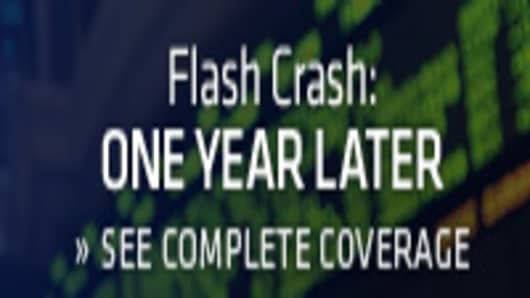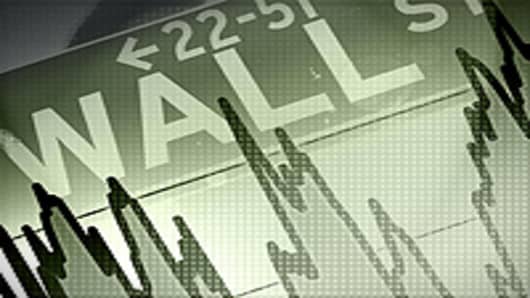The good news: we haven't had another Flash Crash, and rules implemented since the Crash have likely reduced the severity of future crashes.
The bad news: the system is still creaky and vulnerable to individual stock mini-disruptions and security breaches, and there is a serious systemic risk from derivatives that has not gone away.
Also: the potential consolidation of exchanges does raise regulatory issues around how much trading influence should be concentrated in one combined exchange.
First, let's give the SEC some credit.
1) After the crash, the first thing they did was implement individual stock circuit breakers for the S&P 500. That was first implemented in part in June, a month after the Flash Crash, and has since been expanded to the Russell 1000, and several hundred ETFs.
A month ago, the SEC released a proposal for a limit-up, limit down rule. This is a refinement of the single stock circuit breakers that is used in the futures market. It would establish a trading band for price movements; trading outside the quotes would be rejected, while those inside would be accepted.
How is this different from the current single stock circuit breaker rule? Under the current rule, if a single stock trades 10 percent above or below it's average price in a 5-minute period, trading in that stock is halted for 5 minutes.
The issue: why halt trading at all? Under the limit-up, limit down rule, trading would be allowed to occur within a band, say trading could occur if the stock traded 10 percent above or below the average price in that five minute period. Outside that, trading could not occur for a set time period.
The advantage: it's less disruptive! It eliminates the crazy quotes; trading is not halted.
This rule will come into force soon — the comment period will end shortly, and will likely debut in September.
One other point: single stock circuit-breakers should be expanded to cover the entire stock universe.
2) The exchanges have implemented uniform clearly-erroneous trade rules that at least requires everyone to abide by the same rules should trades by busted. This is a good move, but why have so many busted trades in the first place? Why not create rules that prevent them from happening? So if the price is, say 30 percent away from the average trade in the last 5 minutes, that could easily be incorporated to prevent those trades from being executed at all.
In a sense, this is what limit up/limit down does: it does not allow you to print orders outside a band.
3) On February 28, 2011 new short selling rules went into effect, requiring that if a security declines by 10 percent from its previous night's close, short selling in that security will only be allowed above the current best bid for the remainder of that trading day and all of the following day.
More New Rules Ahead
4) The SEC has banned naked access, which goes into effect July 14, which will prevent high frequency traders from gaining direct access to exchanges...all trades will have to pass through a broker dealer and do mandatory risk checks.
5) The SEC banned stub quotes last October, which allowed market makers to fulfill their requirement as market makers by putting in ludicrous bids of $0.01...which actually got hit in a few cases during the Flash Crash.
Now, market makers have to post bids and offers within 8 percent of the National Best Bid and Offer NBBO)...still pretty wide, but a lot better than a penny.
What should the SEC do next? Not to be cynical, but it is really a moot point. The SEC simply does not have the staff to aggressively pursue a widespread overhaul of the U.S. trading system. They are overwhelmed with implementing Dodd/Frank financial reforms. The most that can happen is modest moves, like the limit up/limit down rule.
With that said, here are some modest proposals:
1) Tighten the market-wide circuit breakers. The joint SEC/CFTC put out several other modest recommendations, including tightening the market wide circuit breakers, which halt trading on the Dow when the market drops 10, 20, and 30 percent. These breakers have only kicked in twice (both on October 27, 1997). The trading halts should be tightened — perhaps to 7 percent, 10 percent, and 15 percent, for example, and switch to the more widely followed S&P 500 instead of the Dow Industrials.
2) A consolidated audit trail has been proposed designed to allow the SEC and FINRA to better monitor trading activity. It's a great idea, but the problem is the cost: we are talking an estimated $3 billion to build it, and perhaps $2 billion to run it each year if the system was operating in real time. The money is not there for a project that big.
One solution: instead of a live system, create a central repository that would allow regulators to go back and put together the trade should they need to do so. It's not live, but it's considerably cheaper.
To some extent, a FINRA system, the Order Audit Trail System (OATS), already exists for Nasdaq stocks and is being expanded in July.
3) Requiring exchanges to be more forthcoming about system breaches, trading glitches, and other problems. While circuit breakers may have reduced the chances of another Flash Crash, what about all these mini-breakdowns we keep hearing about, like the one that occurred at nasdaq last week? Or the busted trades in some pharmaceutical stocks that occured after hours on Monday?
There are two causes of these mini-breakdowns: 1) system glitches from the exchanges, and 2) bad algorithms, which occur due to operator mishap or a coding error. With bad algorithms, you can suddenly get buy or sell orders multiple times more than was intended, or orders that are routed to venues with little or no liquidity.
Can It Happen Again?
The most frustrating thing about them: it's very hard to figure out what happened. If it's a technical glitch at an exchange, the exchanges are reluctant to publicize it. And what trading desk wants to admit to an algorithm gone wild?
It's not just system glitches and algos gone wild. Even more worrisome is outright breaches of security, like what happened to Nasdaq in February, when hackers got into a program Nasdaq used for exchanging infomation on boards of directors.
We not only need more disclosure about these kinds of glitches and breaches, we need a broader array of vulnerability assessment on the security of the trading systems in general.
4) More discussion about the proper role of high frequency trading. When we did our Man vs. Machine specialin September, I said it was unlikely there would be any movement on this, and so far that's right. It's simply too contentious and disruptive.
Should ETFs be licensed and administered by FINRA? It would add a qualitative standard to the players in the high frequency space. Some kind of regulatory oversight? Why not raise the standard for traders in general, and do the same thing we do for broker dealers who deal with the public?
Can a Flash Crash happen again? The answer is that while the SEC has taken steps to greatly reduce the chances of a Flash Crash, there's no guarantee that some kind of crash couldn't happen — from a different direction.
My biggest worry: derivative risk is too high, and we need to develop a roadmap to reduce the risk. In a sense, the Flash Crash was a derivative meltdown, if you believe the argument that a large mutual fund executed a (seriously faulty) multi-billion dollar sell program in a matter of minutes using the S&P E-mini futures (some dispute this).
Regardless, we all know there are literally trillions of dollars in derivatives floating around, and all the securities markets are linked together. One major problem is the lack of a central clearing process, which creates counterparty risk.
Why don't we have a central clearing system?
Because Wall Street doesn't want it — it's too profitable to have an over-the-counter dealer system. The Street enjoys enormous profits from the wide bid/ask spreads. Putting them on a central clearinghouse would narrow the bid/ask spreads, despite protestations to the contrary from the Street.
Dodd/Frank contemplates modest moves in that direction, but expect the implacable hostility of Wall Street to continue.
Finally, one last issue to consider: what does the worldwide consolidation of exchanges mean for future trading, and future (global) Flash Crashes?
Let's look at the two competing offers for the NYSE, from Nasdaq/ICE and Deutsche Boerse. If New York does the deal with Deutsche Boerse, it seems it would do little pro or con. The country is still divided into Nasdaq vs. NYSE.
And remember: trading in the U.S. would still be controlled by U.S. regulators, not German regulators.
However, if NYSE combines with Nasdaq , and that combined trading system goes down, then you have at least half of all stock trading out of commission: all you have left is BATS and Direct Edge, and the dark pools.
Why should we assume the two trading systems would be combined? Because cost synergies are a major driver of the deal. In regulatory terms, you may be doubling the risk, because there are so many eggs in one basket.
This is the SEC's call, not the DOJ. The SEC could rule that too much market share (about 50 percent of all trading volume) is a centralization of risk that is unwarranted.
_____________________________
Bookmark CNBC Data Pages:
_____________________________
Want updates whenever a Trader Talk blog is filed? Follow me on Twitter: twitter.com/BobPisani.
Questions? Comments? tradertalk@cnbc.com







